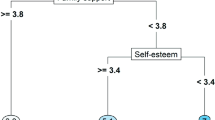Abstract
Visual Predictive Checks (VPC) are graphical tools to help decide whether a given model could have plausibly generated a given set of real data. Typically, time-course data is binned into time intervals, then statistics are calculated on the real data and data simulated from the model, and represented graphically for each interval. Poor selection of bins can easily lead to incorrect model diagnosis. We propose an automatic binning strategy that improves reliability of model diagnosis using VPC. It is implemented in version 4 of the Monolix software.







Similar content being viewed by others
References
Hooker A, Karlsson MO, Jonsson EN. Visual predictive check (VPC) using XPOSE. http://xpose.sourceforge.net/generic_chm/xpose.VPC.htm
Holford N (2005) VPC, the visual predictive check – superiority to standard diagnostic (Rorschach) plots. In: PAGE 2005 (http://www.page-meeting.org/?abstract=738)
Karlsson MO, Savic R (2007) Diagnosing model diagnostics. Clin Pharmacol Ther 82:17–20
Karlsson MO, Holford N (2008) A tutorial on visual predictive checks. In: PAGE 2008 (http://www.page-meeting.org/pdf_assets/8694-Karlsson_Holford_VPC_Tutorial_hires.pdf)
Yano Y, Beal SL, Sheiner LB (2001) Evaluating pharmacokinetic/pharmacodynamic models using the posterior predictive check. J Pharmacokin Pharmacodynam 28(2):171–192
Post TM, Freijer JI, Ploeger BA, Danhof M (2008) Extensions to the visual predictive check to facilitate model performance evaluation. J Pharmacokinet Pharmacodyn 35:185–02
Comets E, Brendel K, Mentré F (2010) Model evaluation in nonlinear mixed effect models, with applications to pharmacokinetics. Journal de la SFdS 151:106–128
Bergstrand M, Hooker AC, Wallin JE, Karlsson MO (2011) Prediction-corrected visual predictive checks for diagnosing nonlinear mixed-effects models. AAPS J 13(2):143–151
Wang D, Zhang S (2011) Standardized visual predictive check versus visual predictive check for model evaluation. J Clin Pharmacol (in press)
Benjamini Y, Hochberg Y (1995) Controlling the false discovery rate: a practical and powerful approach to multiple testing. J Roy Stat Soc B 57:289–300
Khachman D, Laffont CM, Concordet D (2010) You have problems to interpret VPC? Try VIPER! In: PAGE 2010 (http://www.page-meeting.org/default.asp?abstract=1892)
Kay SM (1998) Fundamentals of statistical signal processing, vol 2. Prentice-Hall, New Jersey
MacQueen JB (1967) Some methods for classification and analysis of multivariate observations. In: Proceedings of 5th Berkeley Symposium on Mathematical Statistics and Probability. University of California Press, Berkeley pp. 281–297
Lavielle M (2005) Using penalized contrasts for the change-point problem. Signal Proc 85(8):1501–1510
Author information
Authors and Affiliations
Corresponding author
Rights and permissions
About this article
Cite this article
Lavielle, M., Bleakley, K. Automatic data binning for improved visual diagnosis of pharmacometric models. J Pharmacokinet Pharmacodyn 38, 861–871 (2011). https://doi.org/10.1007/s10928-011-9223-3
Received:
Accepted:
Published:
Issue Date:
DOI: https://doi.org/10.1007/s10928-011-9223-3




